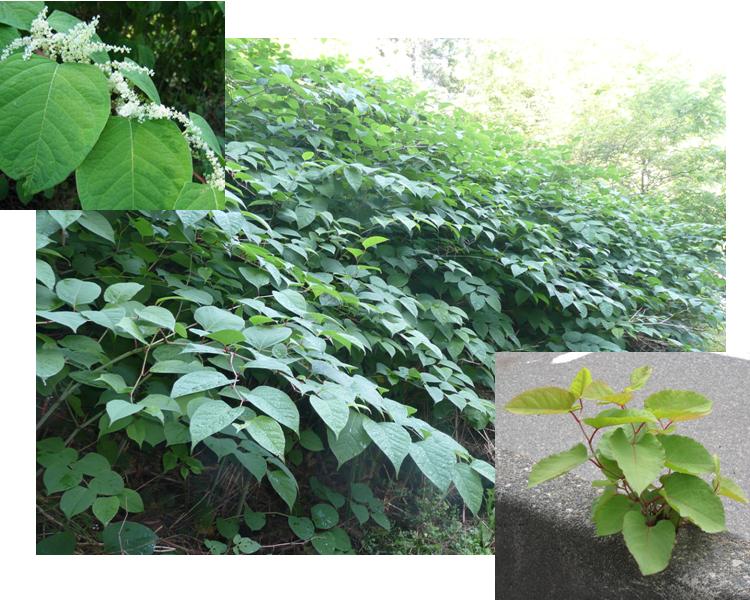
By any standards Japanese knotweed (Fallopia japonica) is an impressive plant. It sprouts from rhizome (root ) fragments as small as 2 cm (less than 1”), reaches heights of 5 m (16.4’), it can grow through asphalt, and it can be found lurking in local gardens! Japanese knotweed (sometimes called Mexican bamboo, Japanese fleece-flower, or wild rhubarb) is a Provincially Noxious invasive plant (designated under the BC Weed Control Act) first introduced into North American gardens in the 1800’s. Japanese knotweed is one of four species of invasive knotweed found in BC: Bohemian (Fallopia x bohemica), Giant (Fallopia sachalinensis) and Himalayan (Polygonum polystachyum). In BC all four knotweed species have “jumped the garden fence” and can be found in along roadsides, lakes, streams, fields, meadows and the ocean. Knotweed infestations form extensive, dense stands that shade out other vegetation and displace native flora and fauna. Dense knotweed infestations along waterways block access by animals and humans. Knotweed’s rhizomerous root system does not stabilize stream banks like native vegetation and results in stream bank failure and increased sediment in the water. Knotweed damage isn’t limited to natural environments. Knotweed is infamous for breaking through drains, concrete foundations and buildings. Removing knotweed from Olympic venue sites added millions to the cost of hosting the 2012 London games.
Identification: Japanese knotweed is a herbaceous, rhizomatous perennial, native to eastern Asia. It has speckled, hollow, bamboo-like stems, arching branches, and large, alternating, green spear shaped leaves of up to 12 cm (4.7 inches) long. Sprays of creamy white flowers appear at the tips of the branches between August and September.
Control: The extensive rhizome system (up to 3 m, 9.8 feet deep and 7 m, 23 feet radius) means treatment often needs to be repeated over several years for long-term control to be achieved. Herbicide treatments, either by stem injection or foliar spray, are generally recommended for complete control. Knotweed can be cut, mowed or grazed but these methods only reduce the height and density of plants they do not control the infestation and the plant will continue to grow once cutting or grazing stops. Cutting stems and covering the stumps with black tarps can slow the spread of knotweed but plants will continue to sprout up around the edges of the tarps requiring the trapped area be repeatedly expanded. Care needs to be taken so that fragments of splintered stem are not spread - plants can re-sprout from the fragments. Cuttings and infested soil should be treated as contaminated waste and be buried deep in landfills, never composted or used as fill! Treated areas should be monitored for many years to ensure that no new shoots appear.
The Northwest Invasive Plant Council (NWIPC) is working to identify all infestations of knotweed on public and private lands with the goal of controlling infestations before they dominate our local environments. You can help by reporting infestations directly to NWIPC (1-866-44WEEDS or [email protected]), or through the provincial Report-A-Weed application for smart phones (www.reportaweedbc.ca) and by getting involved in local invasive plant control efforts. Check out www.nwipc.org for more information and to find events in your area.
ONGOING SEARCH
The NWIPC is looking for an outgoing individual who enjoys meeting with the public. You will have or being willing to...
Excutive Director Search
The NWIPC is searching for an Executive Director to take over from the current Executive Director. This is a...